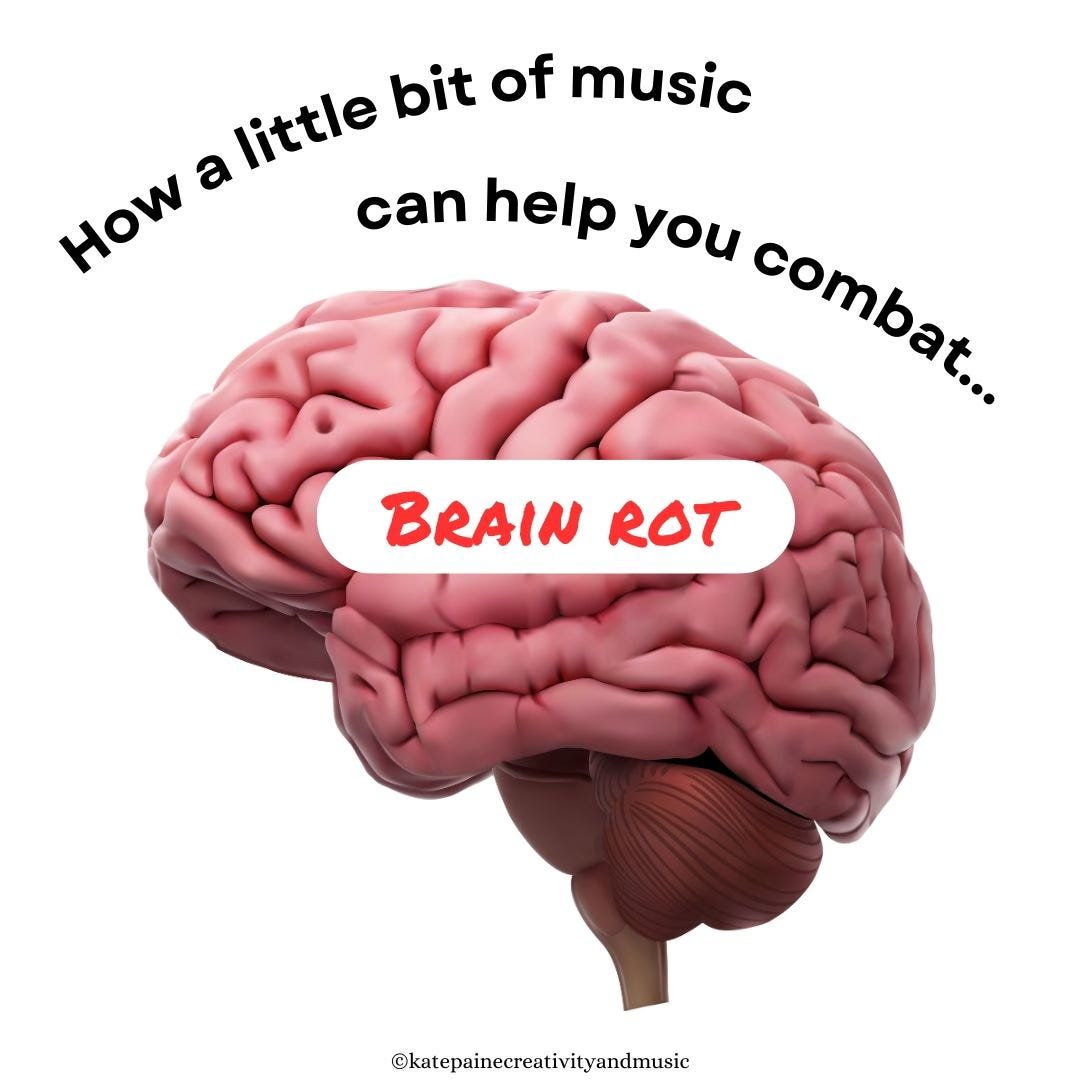Did you know that the Oxford Dictionary word of the year for 2024 is brain rot?
I know, I know. It’s actually two words, right? But I’m going to suggest that this oversight is just a little bit symptomatic of …brain rot.
Apparently, frequency of use of brain rot in social media increased by 230 percent in the period 2023/2024.
Not really surprising, given our increasing worries about the internet, social media, multitasking, microplastics, and whatever else we fear is impacting our ability to concentrate and take in and retain information. Plus, let’s not forget what seems like our inevitable descent into a state of desperate mindlessness.
Surprisingly, brain rot is not a new term. It first appeared in 1854 in the book Walden, by Henry David Thoreau, in which it was used to refer to a decline in mental effort. Sound familiar?
But never fear!
Because I am here with a few musical suggestions to help combat your own slide into mindlessness. Ready?
Music can be a wonderful tool for practicing shifting your brain into a different gear. This is true at any level of experience and skill, and whether or not you play an instrument or sing. And it holds true for all kinds of music.
When you really focus in on something, your brain has no choice but to come along for the ride until you’re fully in the moment. This kind of focused attention is very similar to what we think of as mindfulness.
But it isn’t easy. It can be a challenge to make yourself stop and really concentrate, and getting started is often the hardest part of all.
But this is where music comes in. It’s a low stress and low stakes way to practice not only focusing but also getting started.
Let’s get started
Simply choosing to really, really listen to a piece of music or song is a great way to get started. And you’ll find that the more you listen to that same piece of music or song and the more familiar you become with it, the more you’ll be able to lose yourself in it.
Make sure you put yourself in an environment in which you can really focus on the music. This might mean a quiet room or it could mean listening with headphones while out and about. For me, train journeys are the perfect setting for some dedicated listening while I stare out the window.
And here are a few other ways to use the power of music:
Take a sound walk. No music, no podcasts, no headphones, just your ears. Spend five or ten minutes walking in your neighbourhood simply listening to what’s around you. Try to notice at least five different sounds. You can also do this inside your home or a garden/park. It can sometimes be a struggle leaving the actual music at home, but now I love leaving the house for a walk in which the only sounds I hear are those in my immediate environment.
Download a free piano app on to your phone or tablet. I like the free version of Perfect Piano (available for Android and iOS). You don’t need to know anything about music or the piano keyboard to do this. Give yourself a few minutes to experiment with the sounds of the keys. Choose a few keys and try playing the notes in a pattern, noticing how different combinations of notes sound together, seeing what you like and dislike. You can also incorporate a bit of rhythm, if you like.
Use your own voice. You can hum or choose a simple sound like aah or dah or similar. Start with a single note that feels comfortable to sing. Then make the sound rise and fall, a bit like a wave. Start low and slide up high, or start high and slide down low. You can turn what you’re doing into a melody, if you like, and also incorporate a bit of rhythm or sing a note on a steady beat, as if you were counting (1, 2, 3, 4, and so on). This can turn into a mini meditation, while at the same time giving you a feel for how your own voice works.
Body percussion. Make up some simple rhythms using just your body. For example, you can tap your knees, clap your hands, snap your fingers, and pat your chest and other parts of your body. Start with something simple like a tap/clap/snap and go from there. You can do this with or without listening to music, experiment with how fast or slow you do it, and combine with a bit of vocalisation (see above).
Call and response. This is where you play around with the body percussion and/or voice with someone else. Take turns making up a rhythm, combination of movements (tap/snap/clap, and so on) or vocalisations for the other person to copy. Try it with your kids!
None of these activities require any special knowledge or equipment. I can’t guarantee you won’t feel like an idiot when you first try them, but I promise that if you keep going you’ll really start to see an increase in your ability to focus, and in your ability to get started.
The key is to approach all of these exercises with curiosity and a sense of play, rather than any judgment. There’s definitely no wrong way to do any of these. And the benefits of a few minutes of focused listening or musical exploration are huge.
Let me know what you think!





I love doing body percussion.